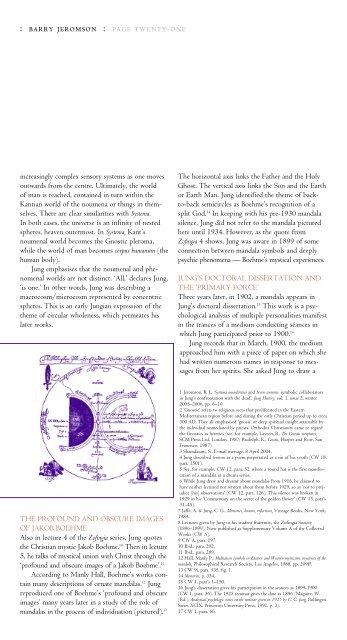a semi-annual publication of the philem n foundation - Philemon ...
a semi-annual publication of the philem n foundation - Philemon ...
a semi-annual publication of the philem n foundation - Philemon ...
You also want an ePaper? Increase the reach of your titles
YUMPU automatically turns print PDFs into web optimized ePapers that Google loves.
: barry jeromson : page twenty-one<br />
increasingly complex sensory systems as one moves<br />
outwards from <strong>the</strong> centre. Ultimately, <strong>the</strong> world<br />
<strong>of</strong> man is reached, contained in turn within <strong>the</strong><br />
Kantian world <strong>of</strong> <strong>the</strong> noumena or things in <strong>the</strong>mselves.<br />
There are clear similarities with Systema.<br />
In both cases, <strong>the</strong> universe is an infinity <strong>of</strong> nested<br />
spheres, heaven outermost. In Systema, Kant’s<br />
noumenal world becomes <strong>the</strong> Gnostic pleroma,<br />
while <strong>the</strong> world <strong>of</strong> man becomes corpus humanum (<strong>the</strong><br />
human body).<br />
Jung emphasises that <strong>the</strong> noumenal and phenomenal<br />
worlds are not distinct. ‘All,’ declares Jung,<br />
‘is one.’ In o<strong>the</strong>r words, Jung was describing a<br />
macrocosm/microcosm represented by concentric<br />
spheres. This is an early Jungian expression <strong>of</strong> <strong>the</strong><br />
<strong>the</strong>me <strong>of</strong> circular wholeness, which permeates his<br />
later works.<br />
THE PROFOUND AND OBSCURE IMAGES<br />
OF JAKOB BOEHME<br />
Also in lecture 4 <strong>of</strong> <strong>the</strong> Z<strong>of</strong>ingia series, Jung quotes<br />
<strong>the</strong> Christian mystic Jakob Boehme. 10 Then in lecture<br />
5, he talks <strong>of</strong> mystical union with Christ through <strong>the</strong><br />
‘pr<strong>of</strong>ound and obscure images <strong>of</strong> a Jakob Boehme’. 11<br />
According to Manly Hall, Boehme’s works contain<br />
many descriptions <strong>of</strong> ornate mandalas. 12 Jung<br />
reproduced one <strong>of</strong> Boehme’s ‘pr<strong>of</strong>ound and obscure<br />
images’ many years later in a study <strong>of</strong> <strong>the</strong> role <strong>of</strong><br />
mandalas in <strong>the</strong> process <strong>of</strong> individuation (pictured). 13<br />
The horizontal axis links <strong>the</strong> Fa<strong>the</strong>r and <strong>the</strong> Holy<br />
Ghost. The vertical axis links <strong>the</strong> Son and <strong>the</strong> Earth<br />
or Earth Man. Jung identified <strong>the</strong> <strong>the</strong>me <strong>of</strong> backto-back<br />
<strong>semi</strong>circles as Boehme’s recognition <strong>of</strong> a<br />
split God. 14 In keeping with his pre-1930 mandala<br />
silence, Jung did not refer to <strong>the</strong> mandala pictured<br />
here until 1934. However, as <strong>the</strong> quote from<br />
Z<strong>of</strong>ingia 4 shows, Jung was aware in 1899 <strong>of</strong> some<br />
connection between mandala symbols and deeply<br />
psychic phenomena — Boehme’s mystical experiences.<br />
JUNG’S DOCTORAL DISSERTATION AND<br />
THE ‘PRIMARY FORCE’<br />
Three years later, in 1902, a mandala appears in<br />
Jung’s doctoral dissertation. 15 This work is a psychological<br />
analysis <strong>of</strong> multiple personalities manifest<br />
in <strong>the</strong> trances <strong>of</strong> a medium conducting séances in<br />
which Jung participated prior to 1900. 16<br />
Jung records that in March, 1900, <strong>the</strong> medium<br />
approached him with a piece <strong>of</strong> paper on which she<br />
had written numerous names in response to messages<br />
from her spirits. She asked Jung to draw a<br />
1 Jeromson, B. J., ‘Systema munditotius and Seven sermons: symbolic collaborators<br />
in Jung’s confrontation with <strong>the</strong> dead’, Jung History, vol. 1, issue 2, winter<br />
2005–2006, pp. 6–10.<br />
2 ‘Gnostic’ refers to religious sects that proliferated in <strong>the</strong> Eastern<br />
Mediterranean region before and during <strong>the</strong> early Christian period up to circa<br />
300 AD. They all emphasised ‘gnosis’ or deep spiritual insight attainable by<br />
<strong>the</strong> individual unmediated by priests. Orthodox Christianity came to regard<br />
<strong>the</strong> Gnostics as heretics (see, for example, Layton, B., The Gnostic scriptures,<br />
SCM Press Ltd, London, 1987; Rudolph, K., Gnosis, Harper and Row, San<br />
Francisco, 1987).<br />
3 Shamdasani, S., E-mail message, 8 April 2004.<br />
4 Jung described Sermons as a poem perpetrated as a sin <strong>of</strong> his youth (CW 18,<br />
para. 1501).<br />
5 See, for example, CW 12, para. 52, where a round hat is <strong>the</strong> first manifestation<br />
<strong>of</strong> a mandala in a dream series.<br />
6 While Jung drew and dreamt about mandalas from 1916, he claimed to<br />
have nei<strong>the</strong>r lectured nor written about <strong>the</strong>m before 1929, so as ‘not to prejudice<br />
[his] observations’ (CW 12, para. 126). This silence was broken in<br />
1929 in his ‘Commentary on <strong>the</strong> secret <strong>of</strong> <strong>the</strong> golden flower’ (CW 13, para’s<br />
31–45).<br />
7 Jaffé, A. & Jung, C. G., Memories, dreams, reflections, Vintage Books, New York,<br />
1989.<br />
8 Lectures given by Jung to his student fraternity, <strong>the</strong> Z<strong>of</strong>ingia Society<br />
(1896–1899). Now published as Supplementary Volume A <strong>of</strong> <strong>the</strong> Collected<br />
Works (CW A).<br />
9 CW A, para. 197.<br />
10 Ibid., para. 202.<br />
11 Ibid., para. 289.<br />
12 Hall, Manly P., Meditation symbols in Eastern and Western mysticism: mysteries <strong>of</strong> <strong>the</strong><br />
mandala, Philosophical Research Society, Los Angeles, 1988, pp. 209ff.<br />
13 CW 9i, para. 535, fig. 1.<br />
14 Memories, p. 334.<br />
15 CW 1, para’s 1–150.<br />
16 Jung’s dissertation gives his participation in <strong>the</strong> seances as 1899-1900<br />
(CW 1, para. 36). The 1925 <strong>semi</strong>nar gives <strong>the</strong> date as 1896 (Maguire, W.<br />
(Ed.), Analytical psychology: notes on <strong>the</strong> <strong>semi</strong>nar given in 1925 by C. G. Jung, Bollingen<br />
Series XCIX, Princeton University Press, 1991, p. 3).<br />
17 CW 1, para. 66.


